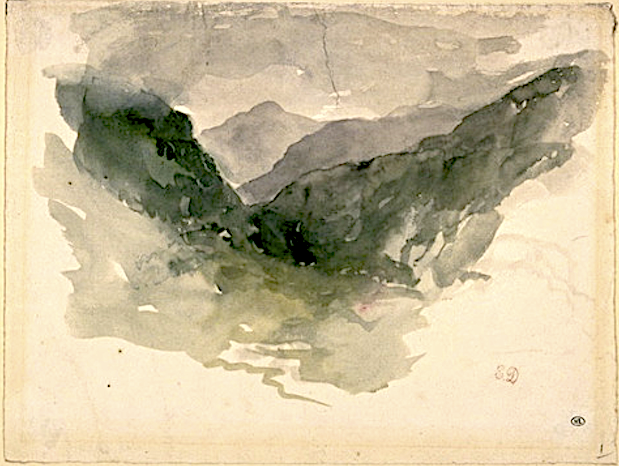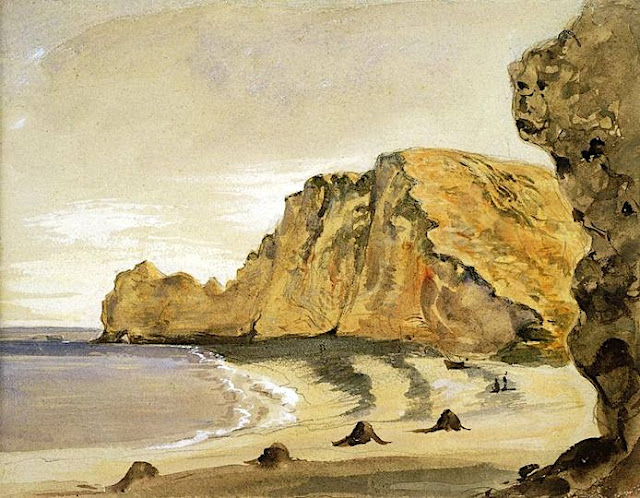 |
SALEH (1811-1880)
Gunung Merapi or Mount Merapi (2,914m - 9,500 ft)
Indonesia (Java)
1. Gunung MerapiDuring the1865 eruption
2. Gurnung Merbabu and Gunung Merapi |
The mountain
Mount Merapi or Gunung Merapi (2,914m - 9,500 ft) is an active stratovolcano located on the border between Central Java and Yogyakarta, Indonesia. It is the most active volcano in Indonesia and has erupted regularly since 1548. It is located approximately 28 kilometres (17 mi) north of Yogyakarta city which has a population of 2.4 million, and thousands of people live on the flanks of the volcano, with villages as high as 1,700 metres (5,600 ft) above sea level.
Smoke can often be seen emerging from the mountaintop, and several eruptions have caused fatalities. Pyroclastic flow from a large explosion killed 27 people on 22 November 1994, mostly in the town of Muntilan, west of the volcano.Another large eruption occurred in 2006, shortly before the Yogyakarta earthquake. In light of the hazards that Merapi poses to populated areas, it has been designated as one of the Decade Volcanoes.
On 25 October 2010 the Indonesian government raised the alert for Mount Merapi to its highest level and warned villagers in threatened areas to move to safer ground. People living within a 20 km (12 mi) zone were told to evacuate. Officials said about 500 volcanic earthquakes had been recorded on the mountain over the weekend of 23–24 October, and that the magma had risen to about 1 kilometre (3,300 ft) below the surface due to the seismic activity. On the afternoon of 25 October 2010 Mount Merapi erupted lava from its southern and southeastern slopes.
The mountain was still erupting on 30 November 2010, but due to lowered eruptive activity on 3 December 2010 the official alert status was reduced to level 3. The volcano is now 2930 metres high, 38 metres lower than before the 2010 eruptions.
After a large eruption in 2010 the characteristic of Mount Merapi was changed. On 18 November 2013 Mount Merapi burst smoke up to 2,000 meters high, one of its first major phreatic eruptions after the 2010 eruption. Researchers said that this eruption occurred due to combined effect of hot volcanic gases and abundant rainfall.
In 2004 an area of 6,410 hectares around Mount Merapi was established as a national park. The decision of the Ministry of Forestry to declare the park has been subsequently challenged in court by The Indonesian Forum for Environment, on grounds of lack of consultation with local residents. During the 2006 eruption of the volcano it was reported that many residents were reluctant to leave because they feared their residences would be confiscated for expansion of the national park, meaning they wouldn't have a house.
Mythology
Merapi is very important to Javanese, especially those living around its crater. As such, there are many myths and beliefs attached to Merapi. It is believed that when the gods had just created the Earth, Java was unbalanced because of the placement of Mount Jamurdipo on the west end of the island. In order to assure balance, the gods (generally represented by Batara Guru) ordered the mountain to be moved to the centre of Java. However, two armourers, Empu Rama and Empu Permadi, were already forging a sacred keris at the site where Mount Jamurdipo was to be moved. The gods warned them that they would be moving a mountain there, and that they should leave; Empu Rama and Empu Permadi ignored that warning. In anger, the gods buried Empu Rama and Empu Permadi under Mount Jamurdipo; their spirits later became the rulers of all mystical beings in the area. In memory of them, Mount Jamurdipo was later renamed Mount Merapi, which means "fire of Rama and Permadi.
The Javanese believe that the Earth is not only populated by human beings, but also by spirits (makhluk halus). Villages near Merapi believe that one of the palaces (in Javanese kraton) used by the rulers of the spirit kingdom lies inside Merapi, ruled by Empu Rama and Empu Permadi. This palace is said to be a spiritual counterpart to the Yogyakarta Sultanate, complete with roads, soldiers, princes, vehicles, and domesticated animals. Besides the rulers, the palace is said to also be populated by the spirits of ancestors who died as righteous people. The spirits of these ancestors are said to live in the palace as royal servants (abdi dalem), occasionally visiting their descendants in dreams to give prophecies or warnings. "
Spirits of Merapi
To keep the volcano quiet and to appease the spirits of the mountain, the Javanese regularly bring offerings on the anniversary of the sultan of Yogyakarta's coronation. For Yogyakarta Sultanate, Merapi holds significant cosmological symbolism, because it is forming a sacred north-south axis line between Merapi peak and Southern Ocean (Indian Ocean). The sacred axis is signified by Merapi peak in the north, the Tugu Yogyakarta (id) monument near Yogyakarta main train station, the axis runs along Malioboro street to Northern Alun-alun (square) across Keraton Yogyakarta (sultan palace), Southern Alun-alun, all the way to Bantul and finally reach Samas and Parangkusumo beach on the estuary of Opak river and Southern Ocean. This sacred axis connected the hyangs or spirits of mountain revered since ancient times—often identified as "Mbah Petruk" by Javanese people—The Sultan of Yogyakarta as the leader of the Javanese kingdom, and Nyi Roro Kidul as the queen of the Southern Ocean, the female ocean deity revered by Javanese people and also mythical consort of Javanese kings.
The painter
Raden Saleh Sjarif Boestaman was a pioneering Indonesian Romantic painter of Arab-Javanese ethnicity. He was considered to be the first "modern" artist from Indonesia (then Dutch East Indies), and his paintings corresponded with nineteenth-century romanticism which was popular in Europe at the time. He also expressed his cultural roots and inventiveness in his work.
Raden Saleh Sjarif Boestaman was born in 1811 in Semarang on the island of Java into a noble Hadhrami family where his father was Sayyid Husen bin Alwi bin Awal bin Yahya, an Indonesian of Arab descent.
Young Raden Saleh was first taught in Bogor by the Belgian artist A.J. Payen. Payen acknowledged the youth's talent, and persuaded the colonial government of the Netherlands to send Raden Saleh to the Netherlands to study art. He arrived in Europe in 1829 and began to study under Cornelius Kruseman and Andreas Schelfhout. From Schelfhout, Raden Saleh furthered his skills as a landscape painter.
During his stay in Paris, Saleh met Horace Vernet whose painting frequently took themes of African wildlife. Compared to Vernet, Saleh's painting seems to be more influenced by the romantic painter Eugène Delacroix. This could be seen in one of Saleh's work, Hunting Lion, 1840, which has similar composition to Delacroix's La Liberté guidant le peuple. However, Werner Kraus, a researcher in the Southeast-Asian Art Center of Passau, German, said that Saleh "never mentioned Delacroix. Perhaps he saw Delacroix's, and possibly Vernet's, works during an exhibition."
While in Europe, in 1836 Saleh became the first indigenous Indonesian to be initiated into Freemasonry. From 1839, he spent five years at the court of Ernest I, Duke of Saxe-Coburg and Gotha, who became an important patron.
Raden Saleh visited several European cities. Many of his paintings were exhibited at the Rijksmuseum in Amsterdam. Several of his paintings were destroyed when the Colonial Dutch pavilion in Paris was burnt in 1931.
Raden Saleh returned to Dutch East Indies in 1852 after living in Europe for 20 years. He worked as conservator for the colonial collection of government art and continued painting portraits of the Javanese aristocracy, and many more landscape paintings.







%20et%20Veleta%20(3%20396%20m)..png)
-Signa%20%20de%20la%20Sauvette-%20Chai%CC%82ne-des-Maures-Fonsation%20FBemberg.jpg)







